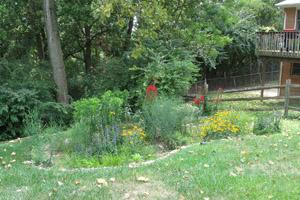EPA Science Matters for Kids: "Green Infrastructure"- Soaking it In!
 Rain Garden
Rain GardenImagine the day after a big storm, walking home from school or running around the playground, and avoiding – or jumping through- all the puddles left over from yesterday. When it rains or when the snow melts on grassy fields, forests, and gardens full of flowers, the water seeps into the soil, where it can be absorbed by the roots of the plants.
But what about sidewalks, roads, parking lots, and roofs? On those surfaces none of the water gets absorbed. And most of the rain water does not become puddles. Instead, it runs down drains, cascades over sidewalks and roads, and sometimes overflows sewers and into nearby creeks, streams, or lakes even far down stream. That can be a big problem for the health of our waterways.
In many areas, all that extra stormwater never gets treated before it makes it to your local body of water. That means it still contains the debris, chemicals, dirt, nutrients, and other pollutants it has picked up on its journey. That can be bad news if you were planning to go swimming or fishing right after a big rainstorm.
One way EPA is helping deal with that extra stormwater is by studying how we use what is called “green infrastructure.” Green infrastructure mimics the way grassy fields, forests, and other natural areas absorb and filter water. By researching how green infrastructure works and the best ways to use it, researchers are helping cities and communities reduce or prevent contaminated stormwater from polluting the waterways.
For example, one thing they are studying is how rain gardens—a kind of green infrastructure—planted at the edges of parking lots, driveways, or sidewalks can help. Rain gardens capture runoff and allow it to seep slowly into the ground. Instead of dirty runoff reaching the storm drain, you get flowers!
Building a rain garden is a fun way to help keep your waterways healthy and learn about the water cycle!
How to build a rain garden
- Find a suitable location for your garden. Whether you’re building your garden at home or at school, there are a few things to keep in mind when choosing the location. Look for areas where there are natural dips and make sure it is located at least 10 feet from a house or building.
- Figure out the best size for your rain garden. Don’t worry too much about this though- big or small, every little bit helps.
- Plan and then stake out the garden area.
- Dig out the garden area to the desired depth. A good range is 4-8 inches to allow water to be captured, but it will also dry between rain events.
- You’re ready to plant! It's best to choose native plants because they generally require the least care. You’ll have to water them for the first few weeks and after that they will be able to mostly take care of themselves (and your extra rain!)
